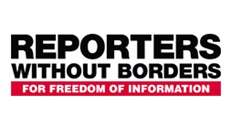India ranks lowly 141 in latest press freedom index
17 Dec 2014
India has been ranked at a low 141 among 180 countries in terms of freedom of speech (a right guaranteed under the Indian Constitution) in the latest report on press freedom by Reporters Without Borders.
 The report released on Tuesday says attacks on journalists have grown more barbaric and kidnappings have soared. In a year when violence against the media took on new proportions, 66 reporters were killed.
The report released on Tuesday says attacks on journalists have grown more barbaric and kidnappings have soared. In a year when violence against the media took on new proportions, 66 reporters were killed.
The organisation said freedom of the press is often sacrificed in the name of national security.
The beheading of James Foley and Steven Sotloff by the Islamic State group highlighted the extreme danger journalists face in covering modern conflicts.
"Rarely have reporters been murdered with such a barbaric sense of propaganda, shocking the entire world," said Reporters Without Borders in their annual report.
There was a slight drop in the number of murdered journalists - down from 71 last year - thanks largely to fewer deaths in countries "at peace".
A total of 720 reporters have been killed since 2005.
But kidnappings soared to 119 - up 37 per cent on last year - thanks to the tactics of separatists in eastern Ukraine and militants operating in the Middle East and North Africa.
"Local journalists pay the highest price, representing 90 per cent of those abducted," the report emphasised.
Of those kidnapped, 33 were in Ukraine, 29 in Libya and 27 in Syria. Forty are still being held.
"Of the 22 journalists currently being held by armed groups in Syria, 16 are Syrians. All of the eight journalists currently held hostage in Iraq are Iraqis."
Press gagged in India
The index names India as one of the countries where freedom of information is sacrificed to national security and surveillance. It talks about Kashmir, where "the work of journalists is handicapped by draconian news control policies".
"Criminal organisations, security forces, demonstrators and armed groups all pose a threat to India's journalists. The violence and the resulting self-censorship is encouraged by the lack of effective investigations by local authorities, who are often quick to abandon them, and inaction on the part of the federal authorities," it said.
"In Kashmir, the authorities impose curfews and often block the internet and mobile phone networks."
Cooked-up cases
Reporters Without Borders highlighted several cases of journalists punished by their governments, including that of Raef Badawi, a Saudi citizen-journalist who won the charity's Press Freedom Prize this year and was sentenced in September to 10 years in prison and 1,000 lashes for "insulting Islam" with his views on the Liberal Saudi Network.
It also highlighted the case of Khadija Ismailova in Azerbaijan - "now Europe's biggest prison for media personnel". Her work on government corruption has made her a target of smear campaigns, blackmail and spurious legal charges.
"Now she is being held on the absurd charge of 'pushing' a former colleague to attempt suicide, a charge that carries a possible sentence of three to seven years in jail," the report said.
Worldwide, a total of 178 professional journalists were in prison as of 8 December - the same number as last year.
China is the world leader in imprisoning journalists, with 33 currently behind bars, followed closely by Eritrea (28) and Iran (19).
Among the high-profile targets is 70-year-old Gao Yu, who won UNESCO's World Press Freedom Prize in 1997. Having already spent seven years in prison in China, she is again on trial for "divulging state secrets" to a German broadcaster.
Conflicts also led to large numbers of journalists fleeing their homes. Forty-seven Libyan and 37 Syrian reporters fled their homeland in the past year. A crackdown on privately-owned Ethiopian media drove 31 journalists into exile.
Beatings and rough handling were most common in Ukraine, followed by Venezuela and Turkey - a symptom of the targeted violence used by police in attempting to suppress protests in those countries this year.
The report "highlights an evolution in the nature of violence against journalists and the way certain kinds, including carefully-staged threats and beheadings, are being used for very clear purposes," it said.
"The murders are becoming more and more barbaric and the number of abductions is growing rapidly, with those carrying them out seeking to prevent independent news coverage and deter scrutiny by the outside world."






















